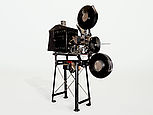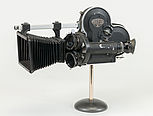The exhibition is temporarily closed until further notice. We apologize for any inconvenience.
Film Pioneers in Berlin
The first public screening of a movie in Germany took place on November 1, 1895 at the “Wintergarten” theater in Berlin. As the finale to a variety show, Max and Emil Skladanowsky, two brothers from Berlin, showed the movie Living Photographs using the Bioscop, a double projector of their own invention. The Bioscop was popularly referred to as the “crank box” (Kurbelkasten), whereas the Royal Patent Office described it as a “device for the intermittent forward motion of a filmstrip to show a series of photographs.” The exhibition highlights Berlin film pioneers like the Skladanowsky brothers and Oskar Messter. The history of film technology is illustrated with abundant historic film footage as well as cameras, spotlights, and other pieces of equipment for making and viewing movies.
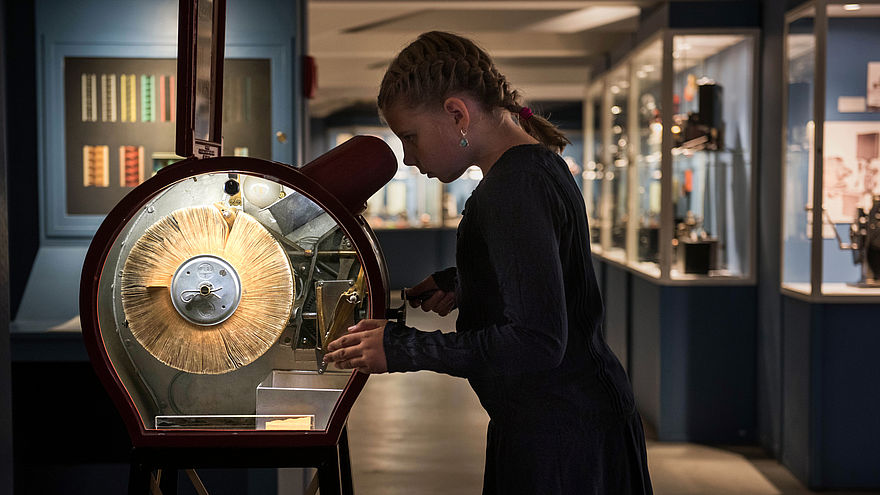
SDTB / U. Steinert
Praxinoscopes, Thaumatropes, Phenakistiscopes
Cinema enjoyed its great breakthrough in the early 20th century, but “moving pictures” had been around for a long time. Projection artists in the 18th century astounded audiences with the laterna magica, or magic lantern. They told stories with colored glass slides that could be moved mechanically, projecting ghost stories or wonders of nature onto the wall. Small versions of the magic lantern were produced in the 19th century as popular toys for children. Visitors to the exhibition can try out these and other optical toys like the praxinoscope, a so-called “magic drum,” the thaumatrope, a rotatable “wonder disk,” and the phenakistiscope, whose name literally means “eye deceiver” or “optical illusion.”
Dreams Need Technology
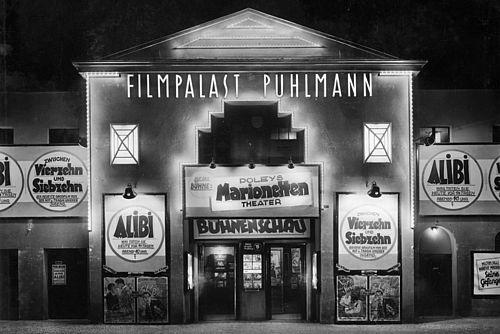
SDTB, Historisches Archiv
Beginning in 1900, innovation in projector and camera technology moved at a rapid pace. Thomas Edison’s 35mm film became standard for filmmaking, opening up new possibilities for storytelling and increasing the popularity of cinema. By the end of the 1920s, there were about 5,000 movie theaters in Germany, and 350 million movie tickets were sold each year. With the triumph of “talkies” in the 1930s, film studios became veritable dream factories. To illustrate the golden age of cinema, the exhibition includes a large model of the Babelsberg Film Studio and a documentary entitled “Film in Film,” about the production of a 1950s feature film.
Amateur Filmmaking: From Super 8 Film to the Video Cassette
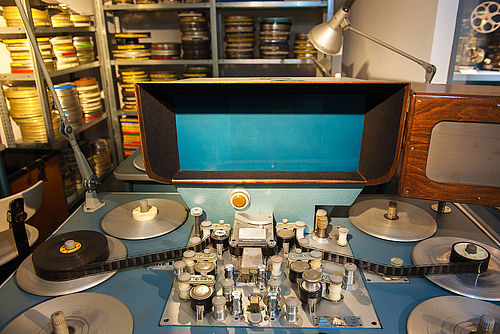
SDTB / C. Kirchner
Technical innovations in film stock have kept cash registers ringing and inspired a growing legion of amateur filmmakers. The narrower the film, the lower the costs involved. 35mm film was simply too expensive for anything but professional use. The 1920s witnessed the advent of 16mm film, whereas 8mm film was introduced in the 1930s, followed by Super 8 in the 1960s (available with sound beginning in 1973). This opened the gates wide to ambitious home-movie-making. The Super 8 era was cut short, however, by the invention of the video cassette. Visitors to the exhibition can follow this development step by step. On display are not only design classics like the Nizo P Super 8 camera, but also fascinating amateur films dating from 1907 to 1985. Take your seats!
Highlights

Max Skladanowsky’s Bioscop film projector
The Bioscop, popularly referred to as the “crank box” (Kurbelkasten), was introduced in Berlin in 1895 by the Skladanowsky brothers. It was one of the first devices for projecting moving pictures. The projectionist turned the crank, thereby advancing two 54mm filmstrips. The Bioscop showed a sequence of a maximum of 24 individual pictures on a continuous loop. Two of the first films were Italian Folk Dance and Boxing Kangaroo.
Replica (original: 1895), on loan from the Deutsches Historisches Museum

Ernemann I film projector
For a long time, the Ernemann I set the standard of film projection in cinemas. It had special fire protection to minimize the danger of nitro film, which was highly flammable. Initially produced for silent movies, this device (gray) was retrofitted with two attachments (black) to allow for optical and magnetic sound playback. Later, the carbon arc lamp was also replaced with a powerful xenon arc lamp.
Ernemann-Werke AG, 1927

“Laterne Riche” magic lantern
The laterna magica was a wildly popular item. Using mechanically moveable colored glass slides, projection artists told gruesome stories to amazed audiences at fairs in the 18th and 19th centuries. These “magic lanterns” also made their way into people’s living rooms. They were produced in many forms and colors as tin toys for children down to the 1920s.
Lapierre Frères, 1880

Arriflex 16 ST movie camera
The Arriflex 16 ST was made by Arnold & Richter KG in Munich. The three Arriflex-Cine-Xenon objectives (2/50mm, 1.4/25mm, 2/16 mm) were made by Schneider Kreuznach. The 16mm camera’s light weight and versatility made it especially popular for sports and news coverage.
Arnold & Richter KG / ARRI AG, 1952



